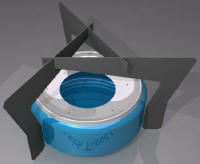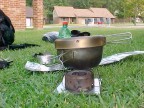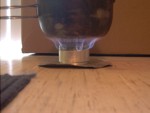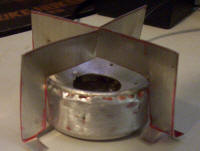
The Worlds Lightest Alcohol Stove!

In 2000 I made my first stove, Roy Robbinson's Cat Stove. At that time I had been using gas stoves and expected a stove to heat as fast as one and simmer on call. Converting me from a gas stove user to an alcohol fan wasn't easy, but the Cat Stove did it because it could boil water fast, just like I was used to with gas, but without all the set up and pumping.
In 2001, http://www.thru-hiker.com/ was a new site, and they were featuring a series of articles about ultralight backpacking strategies. One of the articles was a piece comparing alcohol stoves to canister stoves. In this comparison, each stove's efficiency was measured by starting weight. I was now a fan of the Alcohol stoves, so I wanted to show that there was a difference in alcohol stove design. I volunteered to test various stoves and write the article scientifically testing the stove to see how truly efficient some of the stove designs were. The challenge was to see if it could really boil water, and do so as efficiently as a canister stove.
 By allowing me to do the piece on
alcohol stoves, AYCE really opened my eyes on that
test. A stove like the Cat may heat like a rocket, but in regards to
weight, alcohol fuel needs a lot of volume to achieve true boil. Propane
and Butane have about twice the BTUs per ounce that alcohol has. So in
that regard, the propane/butane stoves have the advantage. But because a
canister stove weighs at a minimum about 3 ounces, and needs a heave
pressure cartridge, the start weight is very close. The logic that I
started working on was average weight carried over the course of a
hike.
By allowing me to do the piece on
alcohol stoves, AYCE really opened my eyes on that
test. A stove like the Cat may heat like a rocket, but in regards to
weight, alcohol fuel needs a lot of volume to achieve true boil. Propane
and Butane have about twice the BTUs per ounce that alcohol has. So in
that regard, the propane/butane stoves have the advantage. But because a
canister stove weighs at a minimum about 3 ounces, and needs a heave
pressure cartridge, the start weight is very close. The logic that I
started working on was average weight carried over the course of a
hike.
So at that point I started looking to make my stove lighter and more fuel efficient. I wanted a stove that could get the maximum performance from the BTUs in alcohol and do so with as little weight and parts as possible. There are some good designs on the internet, but most are aimed at making light and small stoves, they haven't really looked for efficiency. But I must caveat this by saying one really efficient performer is out there - the Trangia, it just isn't the lightest.
So I do a little research. Science has already figured out a lot of the facts for us, all we need to do is search and ask question. First thing I looked up is how many BTUs are in Alcohol.
Methyl Alcohol has 10,200 BTUs per pound and is made from wood grains. It is also the type of alcohol that causes blindness and death if ingested. Methyl Alcohol is sold as HEET fuel line dryer and also comprises 80% of what is sold as denatured alcohol in the 32 ounce cans at Wal-Mart.
Ethyl Alcohol has 12,550 BTUs per pound and is made from grains. It's what you drink in beer, tequila, etc. You can get it as Everclear (90% pure) or in denatured alcohol from Wal-Mart because it makes up the other 20% of that formula.
Compared to Propane/Butane or gas with about 21,000 BTUs per pound, you can see what the problem could be with alcohol.
So the next thing I had to figure out is what the exact definition of a BTU is. Well, a BTU is the amount of energy required to raise the temperature of a pound of water by one degree. A 60 degree pint of water needs about 152 BTUs of energy to achieve boil. SO if a pound of methyl alcohol has about 10,200 BTUs what does that mean?
A pound of alcohol is approximately 19.5 fluid ounces, which equals 577 ml. A ml of alcohol has 17.6 BTUs - so it would take about 9 ml of fuel to boil the 60 degree pint of water in a stove that is 100% efficient. Since no stove is 100% efficient, we will accept aim to make it as efficient as possible.
Something I should point out at this point is that a
canister stove should only need .096 ounces of fuel to boil if it was 100%
efficient, but based on tests from AYCEs http://thru-hiker.com/, they need about 3 times that. That
would make this stove type only about 30% efficient.
So now I have an idea of how much fuel is needed that is scientifically arrived at. But I also know that even a stove as well designed as the SnowPeak is only 30% efficient. What efficiency should I am for? I started at 50% efficiency, which would mean about 18ml of fuel. I started working on my Turbo V8 stove and with some tweaks, I achieved this. And it performed that way consistently and still maintained some good boil times. I was also able to make a soda can stove do the same thing with the ability to simmer.
But not only was I able to do this, but Aaron Rosenbloom of Brasslite did it too with his amazing little stoves the Solo and Duo. But where I used air + fuel = fire, he got it done with a cool system that develops pressure to get rapid heating with good fuel efficiency. Based on the Brasslite design, and my V8 stove, I thought I had hit the limit of performance.
Then I got a Trangia to test. The thing was even more efficient than anything I tested before. It boiled water very consistently on 15 ml of fuel, making it 60% efficient. But it is way to heavy to be weight efficient overall. I wanted to make a lighter stove just as efficient, so I played around with a new design and even made a smaller version of AYCEs V8 stove again. I actually hit 12 ml of fuel to boil which is 75% efficiency, but it was never consistent, and the design was so finicky you would put it out if you removed the pot and then put it back on the stove.
 Finally I decided to try making a smaller Turbo V8 and changing
the burner holes, nothing to lose. Guess what? It
worked! I originally was going to call the stove the Turbo V8 Micro, but
the new stove isn't made from V8 cans, but grape juice, and the stove
really has little in common anymore with the original V8 that AYCE has on
his site. The stove is a double wall alcohol stove that uses fiberglass
wicking material to improve cold weather performance. It primes in it's
own filling hole, uses a built in stove stand, and uses a burner pattern
to control the burning of the fuel.
Finally I decided to try making a smaller Turbo V8 and changing
the burner holes, nothing to lose. Guess what? It
worked! I originally was going to call the stove the Turbo V8 Micro, but
the new stove isn't made from V8 cans, but grape juice, and the stove
really has little in common anymore with the original V8 that AYCE has on
his site. The stove is a double wall alcohol stove that uses fiberglass
wicking material to improve cold weather performance. It primes in it's
own filling hole, uses a built in stove stand, and uses a burner pattern
to control the burning of the fuel.
On AT Forums, Early Riser compared the design to the NASA Ion Drive which uses a highly weight efficient low power drive to produce speeds that could not be re-produced by chemical rockets, but the engine takes a long time to reach those speeds. I like that analogy, so I decided to name the stove after the Ion drive.
In my tests of the original Ion stove, I could only
get the performance to 12ml which would make the stove 75% efficient, but
I found this stove was not as consistent in field conditions as I would
like. The stove design was also not that easy to build, and the design was
not as stable as it could be.
When I posted that stove, I made sure
people knew it was still a work in progress and not a final design; after
all it was just basically a shrunken Turbo V8 stove (http://hikinghq.net/sgt_stove/sgt_v8stove.html)
Then
the war started and I was sent to Iraq. Design and testing work was ceased
for a while, until I had some free time and some alcohol to play with. At
that point I started working on a new design that just sort of evolved in
my head after playing with air flow and pot height. What I found was that
a lot of the design things done to a stove don’t really matter when it
comes to performance, what does matter is:
1. Keeping the flame as centered under the bottom of
the pot as possible. The best way to do this is to not make a wide burner
pattern like most soda can stove have
2. Preventing the flames from
getting too big, too fast, this can be done by limiting the burner area
thus limiting the amount of fuel that can vaporize and burn at any one
time.
3. Put the pot in the optimal place on the flame which is the
point where the flames start to turn orange. This is done based on stove
design and pot design and can require some trail and error.
4.
Windscreen design. This is a very important factor but really separate
from stove design. The only integral factor really is how tall to make
one, and since weight is the issue, then keeping the stove and pot stand
as short as possible is the best way to make sure you only need to use
minimal material in the windscreen.
So if fancy double walls,
pressurization, super air flow, etc don’t make a stove work any better,
then how do you make a stove that is as simple as possible yet provides
the efficiency you need?
 Well start with the
smallest, shortest possible fuel container/burner that could hold up to 1
ounce of fuel. This way you are not limited to the minimum required to
boil a pint in good weather so that if you need more water heated or there
are cold temperatures that require more fuel, you do have the option to
use more. For this I figured a container about 2” diameter and ¾”tall
should be about right. The V8 style cans (Red Bull, small juice cans, etc)
are the right diameter, but they are curved on the bottom which uses up
some space that could be used for fuel. I have looked around but haven’t
found anything yet that is as suitable. So the easy fix was to pound out
the bottom as best as possible.
Well start with the
smallest, shortest possible fuel container/burner that could hold up to 1
ounce of fuel. This way you are not limited to the minimum required to
boil a pint in good weather so that if you need more water heated or there
are cold temperatures that require more fuel, you do have the option to
use more. For this I figured a container about 2” diameter and ¾”tall
should be about right. The V8 style cans (Red Bull, small juice cans, etc)
are the right diameter, but they are curved on the bottom which uses up
some space that could be used for fuel. I have looked around but haven’t
found anything yet that is as suitable. So the easy fix was to pound out
the bottom as best as possible.
The next thing was to make the
burner as small as possible. To do this I tried using just a ¾” hole for
filling and priming in the center of the burner, but this limited the flow
just a little too much. I tried various burner-hole configurations and
came up with a 7/8” center hole with a circle of six smaller burner holes
in a 1-1/2” circle. This allowed for the fastest warm up of the stove
without allowing it to get too hot too fast while also keeping a nice halo
of orange flame right at the bottom of the pot.
To keep the pot in
the “sweet spot” of the stove, I played with the height of the pot stand
until I hit right at 5/8” above the burner which worked equally as well
with my curved bottom pot and various straight sided pots I tried.
As for windscreen, well I already cracked the code on that…
The last thing to figure out at that point was what material to make a pot stand from? The issue is to make a stand that is light, strong, and won't act like a heat sink and use up some of the heat energy created by the stove. Again, http://www.thru-hiker.com/ and AYCE came through with military grade titanium. With a little experimentation and a good idea from Black Dog, the TiPod was born.
Putting the whole thing together, I think this stove is the Unobtanium of alcohol stoves!

